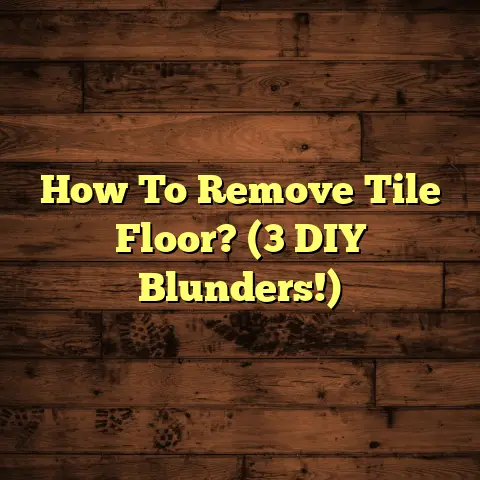Kerosene On Concrete: How To? (5 Min Solution!)
I’ve spent years wrestling with all sorts of flooring dilemmas, and I’m here to share some hard-earned wisdom.
These days, everyone’s talking about going green. And rightly so! We’re all trying to find ways to clean up our act, literally and figuratively.
That means ditching harsh chemicals whenever possible and opting for eco-friendly cleaning solutions.
But what do you do when you’re faced with a seriously stubborn stain on your concrete? A stain that just won’t budge, no matter what you throw at it?
That’s where kerosene comes in. Now, I know what you’re thinking: “Kerosene? Isn’t that stuff… old school?”
Well, yeah, it is. But sometimes, old school is exactly what you need. Kerosene can be a surprisingly effective solution for tackling specific concrete issues.
Think of it as a quick and dirty fix for things like oil stains, paint splatters, or other nasty residues that just won’t quit.
The benefits? It’s readily available, relatively cheap, and packs a serious solvent punch. But before you go dousing your driveway, let’s dive into the nitty-gritty. I’m going to walk you through the right way to use kerosene on concrete, safely and effectively.
Plus, we’ll explore some greener alternatives for those times when you want to keep things eco-friendly.
Section 1: Understanding Kerosene and Its Applications
So, what exactly is kerosene? Well, it’s a thin, clear liquid derived from petroleum. Chemically speaking, it’s a mixture of hydrocarbons.
These hydrocarbons are what give kerosene its solvent properties, meaning it can dissolve other substances. That’s why it’s so good at breaking down things like grease and oil.
Historically, kerosene has been a workhorse in the cleaning world. It’s been used for everything from degreasing machinery to removing tar from roads. In industrial settings, it’s often the go-to solution for tough cleaning jobs.
Think of it like this: your grandma’s secret weapon for getting tough stains out of her prize-winning tablecloth.
Now, how does kerosene stack up against other common cleaning agents? Let’s compare:
| Cleaning Agent | Pros | Cons |
|---|---|---|
| Kerosene | Strong solvent, readily available, cheap | Flammable, strong odor, not eco-friendly |
| Bleach | Disinfects, whitens | Corrosive, harmful fumes, can damage surfaces |
| Vinegar | Natural, readily available | Weak solvent, may not work on tough stains |
| Commercial Degreaser | Effective, readily available | Can be expensive, may contain harsh chemicals |
As you can see, kerosene has its advantages. It’s a potent solvent that’s easy to get your hands on. But it also has some significant drawbacks.
It’s flammable, it stinks, and it’s definitely not the most eco-friendly option out there. That’s why it’s crucial to use it responsibly and only when necessary.
Section 2: Safety Precautions When Using Kerosene
Alright, safety first! Kerosene is no joke. It’s flammable and can be harmful if you’re not careful. Before you even think about cracking open that can, you need to take some precautions.
First off, gear up. I’m talking gloves, goggles, and a mask. You don’t want this stuff getting on your skin, in your eyes, or in your lungs. Trust me, kerosene fumes are not a pleasant experience.
Make sure you’re working in a well- ventilated area. Open those windows, turn on a fan, do whatever it takes to get some fresh air circulating. You want to minimize your exposure to those fumes as much as possible.
And this should go without saying, but keep a fire extinguisher nearby. Kerosene is flammable, so you need to be prepared for the worst. Also, absolutely no open flames! No smoking, no lighters, no candles. You get the picture.
Before you go slathering kerosene all over your concrete, do a patch test. Find an inconspicuous area, like a corner or behind a bush, and apply a small amount of kerosene.
Wait a few minutes, then wipe it off. Check for any discoloration or damage to the concrete. This will help you avoid any nasty surprises on a larger scale.
I always recommend a patch test, even for seasoned pros. It’s better to be safe than sorry, right?
Section 3: The Step-by-Step Process of Using Kerosene on Concrete
Okay, you’ve got your safety gear on, your ventilation is sorted, and you’ve done your patch test. Now it’s time to get down to business. Here’s my step-by-step guide to using kerosene on concrete:
1. Preparation:
First, gather your supplies. You’ll need:
- Kerosene
- Absorbent cloths or rags
- A stiff brush (if needed)
- A container for used materials (like an old bucket)
Clear the area of any furniture, plants, or other obstacles. You want to have plenty of room to work and avoid getting kerosene on anything you don’t want it on.
2. Application:
Pour a small amount of kerosene onto the stained area or onto a clean cloth. Don’t go overboard! A little goes a long way.
If you’re using a cloth, dab it onto the stain. If you’re pouring directly, be careful not to saturate the concrete.
Use a brush or cloth to gently scrub the stained area. Let the kerosene do its thing and penetrate the stain. You might need to apply a little elbow grease, but don’t go too crazy.
3. Absorption:
Now, let the kerosene sit for a few minutes. This gives it time to break down the stain. I usually give it about 5-10 minutes, depending on how stubborn the stain is.
Use clean rags to blot up the kerosene and stain mixture. Don’t rub! Blotting will help lift the stain without spreading it.
Keep blotting until you’ve absorbed as much of the kerosene and stain as possible. You might need to use several rags.
4. Final Cleaning:
Rinse the area with water or a gentle concrete cleaner to remove any remaining kerosene residue. I like to use a mild soap and water solution.
This step is crucial for getting rid of that kerosene smell and preventing any potential damage to the concrete.
Dry the surface with a clean cloth or let it air dry. Once it’s dry, take a look and assess the effectiveness of the cleaning process.
Did the stain come out completely? If not, you might need to repeat the process.
Section 4: Troubleshooting Common Issues
Even with the best laid plans, things can sometimes go wrong. Here are some common problems you might encounter when using kerosene on concrete, and how to fix them:
-
Stains that don’t come out completely:
Sometimes, a stain is just too stubborn for a single application of kerosene. If this happens, don’t despair!
Repeat the application process. Apply more kerosene, let it sit for a bit longer, and then blot it up. You might need to do this several times to fully remove the stain.
You could also try using a stiffer brush to scrub the stain. Just be careful not to damage the concrete surface.
-
Damage to the concrete surface:
Prolonged contact with kerosene can sometimes damage concrete, especially if it’s a porous or unsealed surface.
If you notice any discoloration or weakening of the concrete, stop using kerosene immediately. Rinse the area thoroughly with water and let it dry.
You might need to apply a concrete sealer to protect the surface and prevent further damage.
-
Kerosene smell that won’t go away:
Kerosene has a strong odor that can linger for a while. To get rid of the smell, try sprinkling baking soda over the affected area.
Let the baking soda sit for a few hours or even overnight, then vacuum it up. Baking soda is great at absorbing odors.
You can also try using a commercial odor eliminator. Just make sure it’s safe for use on concrete.
If kerosene just isn’t cutting it, don’t be afraid to try a different cleaning agent. There are plenty of other options out there, including commercial concrete cleaners and eco-friendly alternatives.
Section 5: Eco-Friendly Alternatives to Kerosene
Okay, let’s talk about the elephant in the room: kerosene is not exactly environmentally friendly.
If you’re looking for greener ways to clean your concrete, you’re in luck. There are plenty of eco-friendly alternatives that are less harmful to the planet.
-
Biodegradable cleaning products:
These products are made from plant-based ingredients and are designed to break down naturally in the environment.
They’re often just as effective as traditional cleaning products, but without the harsh chemicals.
-
Vinegar and baking soda mixtures:
This classic combination is a powerhouse for cleaning all sorts of surfaces, including concrete.
Mix equal parts vinegar and baking soda to create a paste, apply it to the stain, let it sit for a few minutes, and then scrub it away.
-
Commercial eco-friendly stain removers:
There are many commercial stain removers that are specifically designed for concrete and are made with eco-friendly ingredients.
These products are often more expensive than traditional cleaners, but they’re worth it if you’re committed to going green.
So, how do these alternatives stack up against kerosene? Let’s take a look:
| Cleaning Agent | Effectiveness | Safety | Eco-Friendliness |
|---|---|---|---|
| Kerosene | High | Low | Low |
| Biodegradable Cleaners | Medium | Medium-High | High |
| Vinegar/Baking Soda | Medium | High | High |
| Eco-Friendly Removers | Medium-High | Medium-High | High |
As you can see, eco-friendly alternatives may not be as potent as kerosene, but they’re much safer for you and the environment.
Conclusion
Alright, we’ve covered a lot of ground here. We’ve talked about what kerosene is, how to use it safely and effectively on concrete, and what to do when things go wrong.
We’ve also explored some eco-friendly alternatives for those times when you want to keep things green.
The bottom line? Kerosene can be a useful tool for tackling tough concrete stains, but it’s important to use it responsibly and with caution.
Always prioritize safety and take the necessary precautions to protect yourself and the environment.
For regular maintenance and cleaning of your concrete surfaces, I encourage you to consider eco-friendly options.
They may not be as quick and dirty as kerosene, but they’re better for the long run. But when you’re faced with a really stubborn stain, kerosene can be a quick and effective solution.
Just remember to use it sparingly and always follow the safety guidelines I’ve outlined. Now go forth and conquer those concrete stains!





